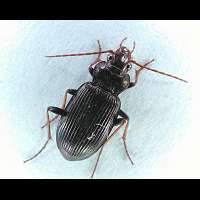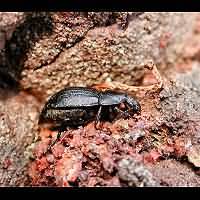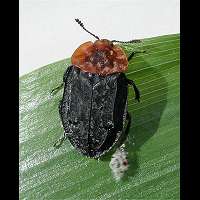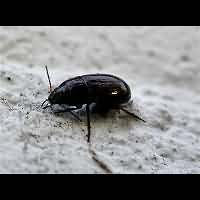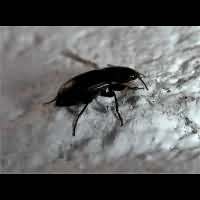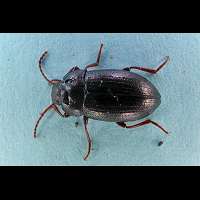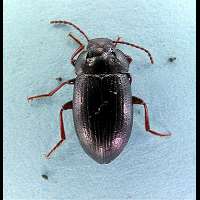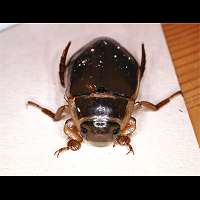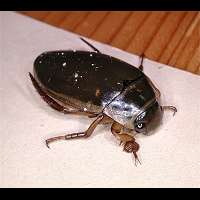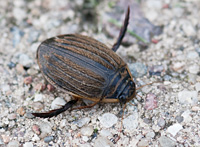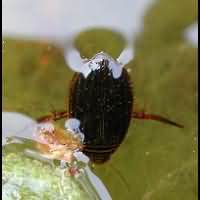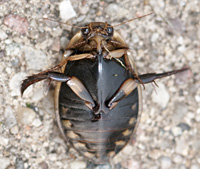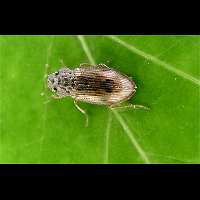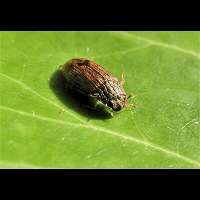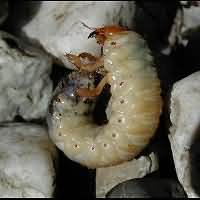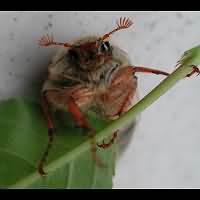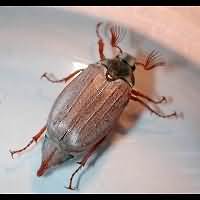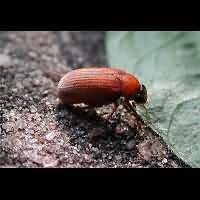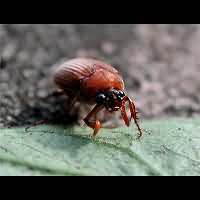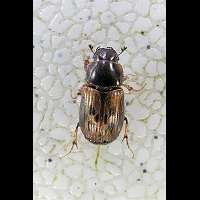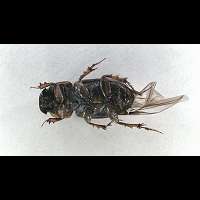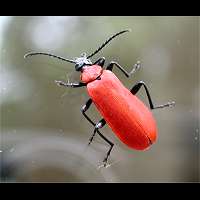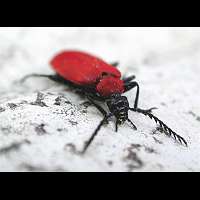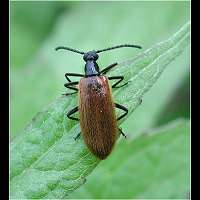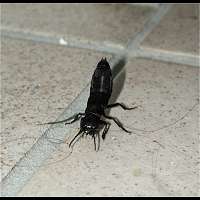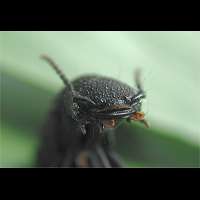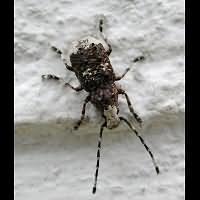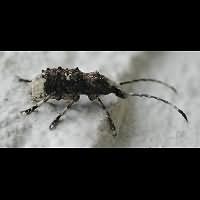Big Beetles (various families)
[All pictures of garden wildlife on this page are thumbnails. Click on any thumbnail for a large format to be displayed.]
Western Europe is located in the temperate zones of the world. This means that real big insects are scarce. The biggest beetle in our parts of the world is the Stag Beetle. It may reach a length of about 75 mm, but a large part of the animal exists of the enormous jaws. Without them the animal reaches approximately 35 mm, so actually it isn't that impressive at all. On this page we have put beetles found in our garden belonging to families comprised of relatively large species such as Carrion Beetles and the Chafers. There is no scientific reason for grouping these families in this way and some families are not even remotely related.
Contents: 1 Ground Beetles, Darkling Beetles and Carrion Beetles, 2 Diving Beetles and Water Beetles, 3 Scarab Beetles, 4 Various other beetles.
![]()
1 Ground Beetles, Darkling Beetles and Carrion Beetles (Carabidae, Tenebrionidae & Silphidae)
Beetles come in many colours. Most of them wear coloration that makes them stand out while others that live on the ground have very dark inconspicuous colours that camouflage their presence. Ground Beetles, also known as Carabid beetles. They chase their prey and most of them are nocturnal species that are especially active at night. Some can be easily found under the rocks and logs. The majority of the carabids is black or brown, even though some have metallic colours. According to Victor Shilenkov the beetle shown below to the right is Nebria brevicollis which is between 10 and 15 mm long. In sunshine it often shows metallic blue shiny colours. This probably is the most common groundbeetle in Europe. You will find it in woods, hedges, but also in gardens and parks, even in the centre of big cities. Studies show this to be the most common species in both London and Hamburg. The eggs are deposited in late summer and the larva overwinters. It is the first ground beetle to leave the pupa in spring. Some other species may only seem to be faster, but those are species of which the adults overwinter. It is a useful species in the garden because it hunts for other beetles including the awful Strawberry Weevil and it also eats aphids. To the right a Carrion Beetle. The name of this family is slightly misleading for many species do not use carrion but they hunt for insects in about the same way Carabids do instead. The species below is very common on the European continent and it lives in most parts of Russia as well. However we are not sure if it lives in the UK. Carrion beetles hardly ever eat the carrion themselves: most adults are vegetarians. Usually swarms of carrion beetles work together on bigger carcasses. As soon as they smell a dead animal, especially a bird or mammal, thet 'run' to it and start digging below the carcas. After a while the dead animal will drop into the hole the carrion beetles dug. They'll deposit their eggs and fill up the whole. The larva will have plenty of food after hatching. An adult Silpha obscura below eats carrion and if no carrion is in stock it even becomes an active hunter! The animal reaches a length of some 14 to 18 mm, but actually it may look bigger because of the round shaped and rather massive body. It is a very common species all over Europe (including most of Britain) and Northern Asia.
To the left Nebria brevicollis, a Ground Beetle and to the right probably Silpha obscura, a Carrion Beetle.
Carrion beetles are the vulptures of cooler areas of Western Europe although but not all of them live off the the remains only. Below a very beautiful bi-coloured species: Oiceoptoma thoracica. These are skilful flyers and it is amazing how quickly they discover a corpse of a dead bird or a small mammal. Initially many beetles join the dinner party on the decaying body. After some time however a couple will form and they will show very dominant behaviour chasing others away. The animals are not only interested in corpses, but in decaying mushrooms and dung as well. Curiously enough this species does not eat the material itself. Both adults and larvae hunt for larvae of other insects, such as flies, eating from the remains. When feeling in danger they spit out their ugly smelling stomach contents. The larvae are black and quite similar to wood lice. The scientific name is also spelled as Oiceoptoma thoracicum.
This badly smelling, but quite beautiful carrion beetle is called Oiceoptoma thoracica.
Black ground beetles are numerous in many gardens. It is often very difficult to tell what species you are looking at. The genus Amara for instance is comprised of a number of black ground beetles, many of which appear in gardens regularly. Both adults and larvae are known to be carnivors. Some species are even experimented with in order to find out whether they can be useful in biological pest control. However recent Danish studies seem to show that the larvae of some species do feed on plants as well. Many experts, among others Denis Keith and Dr. Arved Lompe are convinced this is an Amara sp., but they are unable to tell us the exact species. Anyway, with these black ground beetle an identification on genus level is quite an achievement! Like many other Amara-species this beetle is some 8 mm.
Another black ground beetle regularly found in gardens: an Amara species.
Darkling Beetles resemble Ground Beetles very much. It is a big beetle family comprised of approximately 15,000 species world wide. In Europe however there are not that many of them. In the Benelux area only some 30 species can be spotted. The majority is, just like the ground beetles, black or brownish. Even though looking like Ground Beetles, there are some differences: the eyes are notched and the hind tarsus (last part of the leg) has 4 segments only (Ground Beetles have 5). There are other differences as well, but these are not that easy to see. Both the larvae and the adult beetles are scavengers. The best known representative is the Mealworm which is a true pest in storage houses. Their larvae are also used as food for certain pets. The species below may appear in gardens with trees for the larvae live in the sandy soil around older trees, especially oak. The beetles are often found in the same trees. It is however a typical species of woodlands and probably not seen in many gardens. Scientifically also known as Cylindronotus laevioctostriatus.
Looking much like a ground beetle, but actually being a Darkling Beetle: Nalassus laevioctostriatus.
2 Diving Beetles and Water Beetles (Dytiscidae & Hydrophilidae)
Even in small ponds you can find Diving Beetles and you might wonder wonder how they got there. Well, the Diving Beetles can do more than just dive: they can fly as well. So they can take many opportunities to explore new wells, ponds and streams. They are among the biggest beetles in the Benelux area: up to 4 centimeters in length! They swim using their back legs. The front and middle legs are used to cling onto plants in the water or to grab a prey. One of the best known water beetles in both Europe and America is the Water Tiger below. The pictures are of a lonely male strolling through our garden on a windy and rainy March evening. We took it inside for a moment where it served as a patient photo model. You can tell the males apart from the females by the strange discs on the front legs. These are sucking discs which are used to get a hold of the fast swimming females during copulation. The Water Tiger is a big animal. The one in the pictures below was almost 38 mm! The adults are long lived and sometimes can be up to 5 years of age. In the moderate climate zones of Europe this is probably the species that lives longest in their adult stage. The larvae live in the water exclusively and my be up to 60 mm long. Both adults and larvae are formidable hunters. Usually the larvae will attack any pray that is not much smaller than they are themselves. Adults really don't care and will attack even fish well over one meter long and bite a piece off it. If you see a chunk of the fish body missing, usually near the back, then it might have been the result of an enounter with the larvae of the Diving Beetle. They may be harmful to fish because even though their bite will not kill the fish, the wounds they make lead disease resulting often in death. The adult Diving Beetles are capable of biting people painfully. Larvae might bite people as well, but their jaws are rarely powerful enough to go through the skin. Better not experiment with the larva because its bite is extremely painful and its digestive acid is immediately injected, making the wound even more painful and slowing down the healing.
Kidnapped and only slightly abused as a photo model when walking in our garden: the male of the Water Tiger (Dytiscus marginalis).
Photos above show the Lesser (or Grooved) Diving Beetle (Acilius sulcatus).
Water Beetles of the family Hydrophilidae are a strange lot. Some are big black beetles and excellent swimmers, others are much smaller, sometimes even colourful. Those living on land and are not even capable of swimming. Diving Beetles take air with them by keeping it under the elytrae. That's why you can see them breathing by sticking their back side out of the water. Water Beetles use their antennae to push air under their body, where it is held with many hairs present there. Except for some bigger species many are not very skillful swimmers and they just crawl over the plants. Helophorus aequalis belongs to a genus of which some members live in the water and others don't. A close relative even is a pest in rape-seed. The species below is always found near water, hardly ever in it. The larvae do live in the water and are fierce predators.
A strange Waterbeetle this Helophorus aequalis, for it hardly ever swims.
3 Scarab Beetles (Scarabaeidae)
All Scarab Beetles have two common factors: they are rather large and bulgy beetles and they all have a kind of fan at the end of their antennae. This fan exists of at least three parts that can be folded together. With the May Bug, also known as Maybeetle or Cockchafer, this fan-shaped antenna is also the way to tell the males and females apart: females have a fan consisting of six parts, while the male's fan has seven members. Just look at the pictures below. On the left you see a white grub, the larva of a Chafer. These larvae are also known as rookworms.
The May Bug (Melolontha melolontha): to the left white grub, in the middle female and to the right male.
Below to the left you see a close relative of the famous Cockchafer: the Bracken Chafer (also known as Garden Chaffer or Garden Foliage Beetle). The adults chew on the buds of plants (roses for instance) and can therefore become a pest if they visit a plant in large numbers. Usually if there are just a few adults around not much damage is done. The larva is much more harmful. They eat grass roots, just under the surface. In this way grass gets detached from its roots. This can be so bad that entire sods can be lifted and underneath you'll see plenty of larvae. And that's not all: moles and birds are keen on these grubs and can do even more damage to the grass when hunting for food. All these animals often become a plague in the neat lawns on tenniscourts and golf clubs. Nowadays the grubs of the Garden Chafer are effectively got rid of using biological weapon: nematods. These are minute worms that are parasites to the grubs, killing them quite quickly. Below to the right a similar species: the Margined Vine Chafer. It is a little bigger, less hairy and always has a green appearance, even on the brown shields. Its larvae are as destructive in lawns as the Bracken's are.
Two lawn destroyers: The Bracken or Garden Chafer, also known as the Garden Foliage Beetle (Phyllopertha horticola) to the left and the similar but greener Margined Vine Chafer (Anomala dubia).
The Brown Chafer (also known as Brown Garden Chafer) has a rusty brown colour indeed. The head is black with striking eyes bulging out. Reaching some 11 mm, it is much smaller than the May Chafer is and almost hairless. The grub lives underground for two years and eats roots of grasses. The species is rarely harmful to agriculture or to your garden because it usually appears in quite small numbers. The same nematod used against Garden Chafers also destroys many Brown ones. The species prefers dry, sandy soil. The May Chafer is a very slow walker while the Brown Chafer is a fast runner.
A smaller cousin of the May Bug: the Brown Chafer (Serica brunnea).
The family of Scarab Beetles is not only comprised of the Chafers, but of the Dung Beetles as well. They look for fresh dung, dig a hole in the earth, put the dung in, lay an egg on it and cover it with earth. After hatching the larvae will feed on the dung. In forests you can often see them move slowly. These are the big, black or blueish black species. Dung beetles are rare in gardens, but we might find one of the numerous smaller species, often belonging to a genus called Aphodius. They are especially attracted to rabbit dung. After hatching the grubs will eat the dung, but may be harmful to grass roots as well. This is why they sometimes cause damage to golf courses. But usually more damage is done by birds that feed on them. Especially rooks and other crow family members can do a lot of so-called secundary damage by turning the grass over searching for the larvae. It is a very common chafer throughout Europe (including the British Isles) and Asia.
Left: a quite spectacular Geotrupes stercorarius , right: Aphodius contaminatus that is one of the smaller dung beetles.
The most common dungbeetle in our part of Europe is Aphodius prodromus below. It is a difficult species to identify because it is extremely similar to another very common species: Aphodius sphacelatus. Both are species that can be found in winter and spring.
In early spring Aphodius prodromus is the favourite source of food for many crows as Jackdaws, Hooded Crows and Rooks.
4 Various other bigger beetles (Various families)
![]()
In this chapter we'll be dealing with some beetles belonging to smaller or rare families of which only very few representatives will pop up in one's garden. There exist about three species of Cardinal Beetles (Fam. Pyrochroidae) in Western Europe and all species are uncommon or even rare. This means we were very lucky to find the Black-headed Cardinal Beetle in our garden. Even though it is not a very big species (14 to 20 mm), it will catch your attention immediately due to its striking red colour. The adults may be found behind the loose bark of moulding trees and they will also visit flowers to eat pollen. The larvae live two or three years in dead, rotting trees. They hunt for other beetle larvae, mainly those of Longhorns and Jewel Beetles. This species can be encountered all over Europe, including most of the British Isles, but it is not common anywhere.
Very uncommon to see in one's garden: the Black-headed Cardinal Beetle (Pyrochroa coccinea).
![]()
Lagria hirta below belongs to its own family of beetles, called the Lagrid Beetles (Lagriidae). A very small family, for it is represented by only two species in Britain. Of the two only this one is quite common. The beetle itself is black, but the shields are brown and covered with small, thin hairs. The beetle reaches a length of about 10mm. The larvae are usually found among leaf litter on the ground, but do live in compost heaps as well. The larva overwinters and pupates in early spring. Adult beetles can be seen from April to October. Lagria hirta prefers meadows, forest clearings, parks and gardens, if not too dry. It is a common species in Wales and most of England, less common in Northern England and a local species in Scotland.
When you are making your own compost, this species, Lagria hirta, is likely to turn up in your garden.
![]()
Would there ever be a competition the best common English name for a beetle, I would certainly nominate the big, black beetle below. It is called the Devil's Coach Horse. It is a very big beetle and an exception within his family of Rove Beetles. Rove Beetles comprise of hundreds of small species, many hardly even reaching 5 mm. The rest of this family is therefore covered in the Small Beetles section of Gardensafari. In Britain there are hundreds of Rove Beetle species. Actually this is the biggest group of beetles in Western Europe. All species have very short shields (elytrae), covering up only one third of the abdomen. The wings are folded under the small shields, much the way earwigs do. Only a few species have lost the ability to fly alltogether. Most species are small, but a few are quite big and misbehave when they feel threatened. Best known is the Devil's Coach Horse. A very common species which is often found in gardens. Especially in autumn it is regularly found indoors, usually causing a mix of panic, fear and amazement. When approached it will lift its head and curl up its abdomen. This makes it look like a very small scorpion. By showing how eager it is to attack it tries to intimidate its enemy. In fact it is a defense strategy. Devil's Coach Horse has big, powerful jaws, easily capable of penetrating the human skin causing a painful bite which won't go away quickly. And on the curled abdomen are two glands producing a very nasty smelling stuff it sprays into your direction. This is a very welcome guest in your garden though because it is very fond of eating snails. Measuring up to 33 mm this is the biggest of all European Rove Beetles. A very common species all over the British Isles, including the Shetlands.
Our biggest Rove Beetle, the Devil's Coach Horse (Staphylinus olens), has the head of an alien...
![]()
The beetle below is a very strange one. It looks like is is covered in fungi and it even has small brushes of hairs growing on top. It belongs to a small family of beetles called the fungus weevils (Anthribidae). They are closely related to the ordinary weevils, only their snout is large and flat. Of course no fungi grow on this beetle, it only looks that way. Actually both the beetle and its larva can be found in and on rotting and mouldy wood. And if you do look like that yourself, your enemies have a hard time finding you!
The White Fungus Beetle (Anthribus albinus)

© Copyright 1998-2024 gardensafari.net (Hania Berdys)

 English / engels
English / engels  Dutch / nederlands
Dutch / nederlands